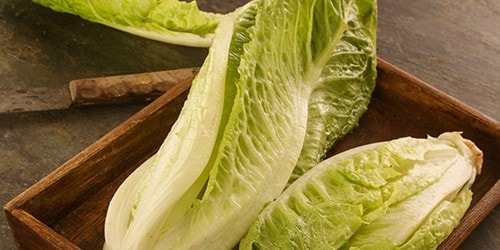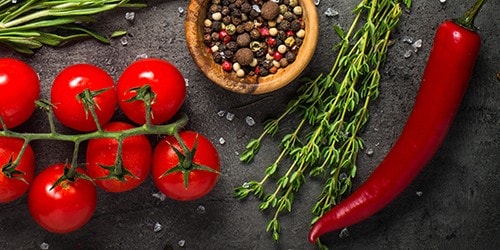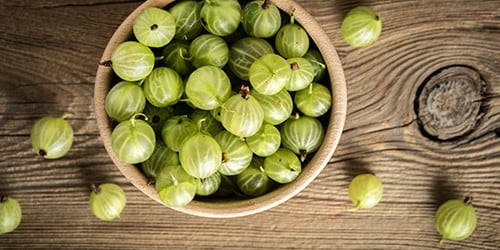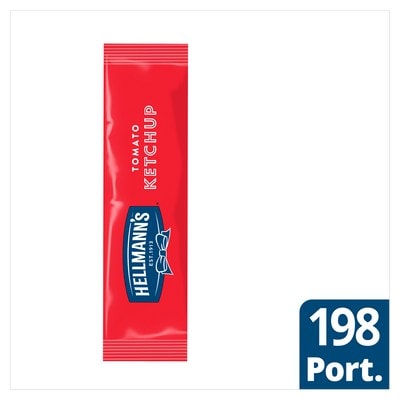
Seasonal in June
British Produce


Imported Produce


Fruit and Vegetables
Vegetables

GEM LETTUCE:
At its best: March to November, peaking in May
Gem lettuce is crisp and buttery with a subtle sweet flavour, it's favoured by chefs for its crunchy texture and ability to withstand heat in cooking. It’s great torn up fresh into a salad to accompany meat, fish, or other vegetables - splashed with a citrus vinaigrette. The grooves of the leaves soak up all the flavours and cut fats, it can also be pan-fried, braised, or grilled. Gem lettuce pairs well with citrus, salad ingredients like tomatoes or radishes, green vegetables, cream or vinegar-based dressings, and most herbs.
Chef Suggestions: For a faultless seasonal salad, try pairing your gem lettuce with blue cheese, bacon, and croutons to enhance its flavour profile.
We recommend: Grill the gem lettuce as a garnish for chicken, guineafowl, or fish dish. For a different approach to your Sunday roast, sauté with peas, butter, stock, and bacon.
Flavour pairings: Mayonnaise, lemon, caper, olive, mint, chive, pea, walnut, parmesan, anchovy, bacon, toasted bread, and blue cheese.

CHERRY TOMATO:
At its best: July to September
Cherry tomatoes are small, sweet, and juicy - making them the ideal snack or ingredient (raw or cooked). They are usually best served whole and raw to maintain their juiciness, in salads or in pasta dishes, whilst the tomatoes develop a richer flavour when roasted. A good drizzle of olive oil, salt, pepper, and basil are simple yet effective garnishes to bring out the tomato’s flavour. Foods such as feta or goats' cheese, vinegar, or dried herbs will counteract the sweetness.
Chef Suggestions: Tomatoes are extremely versatile and can be cooked in numerous ways. When you need to use up tomatoes, they are great as a part of a traditional base, sauce, and soup.
We recommend: When preparing tomatoes, you can fry, sauté, grill, and roast them to enhance their flavour profile. Tomatoes are great to puree or dehydrate for a rich dish.
Flavour Pairings: Cheese, Basil, onion, garlic, olive, caper, coriander, rosemary, thyme, lamb, fish and shellfish, and avocado.
Fruit

Raspberries:
At its best: June – September
Raspberries are not only delicious but also packed with nutrients. They are an excellent source of vitamin C, dietary fibre, and antioxidants. As a soft berry, Raspberries are naturally commonly eaten fresh, but a glut of harvest is great for jams, preserves, sorbets, or baked goods. They can also be frozen if evenly spaced out and gently defrosted in the fridge.
Chef Suggestions: When selecting raspberries, Scotland produces amazing ones due to their longer daylight hours during the temperate summer months. Look for bright, evenly coloured, and plump berries. Avoid raspberries that still have their hulls attached, as this suggests they were picked prematurely and are not fully ripe.
We recommend: Raspberries can be added to desserts like pies, cakes, and tarts or breakfast dishes like oatmeal or smoothies. They also pair well with strong meats like game and duck and can be used to create delicious sauces. In addition, raspberries can be used to craft refreshing cocktails.
Flavour profile: Sweet, tart and slightly floral
Flavour pairings: Chocolate, mint, oats, cinnamon, basil, ginger, and almonds are perfect pairings. For example, in the classic Bakewell tart, almonds help to mellow the fruit's sharper edges while still allowing the fruit to shine. Soft, young cheeses like goat cheese with its lactic tang also complement these flavours. Additionally, raspberries pair well with duck, turkey, chocolate, and oats.

Redcurrants:
At its best: June and July
Redcurrants are small berries that have a distinctive tart taste, yet they are still sweet enough to be consumed raw with the addition of sugar. They are high in vitamin C, which is essential for maintaining a healthy immune system and promoting collagen production in the body. Redcurrants are often used in jams, jellies, and sauces, and they are also a popular ingredient in baking. These berries have a brilliant bright red colour and a firm texture, making them perfect for a range of dishes.
Chef Suggestions: can be eaten raw or cooked. Gently poach them for 2 minutes, to soften the skin. After poaching, sprinkle them with sugar and serve with cream. You can also use them to make sauces, syrups, and jams. Redcurrants can be added to fruit mixes for summer pudding, used to create mousse, or made into refreshing sorbets.
We recommend: To detach the berries from the stalks, grasp each stalk at the top while holding the berries at the bottom and gently slide a fork along each one. The berries should separate effortlessly, without damaging. Rinse them thoroughly before using. Go for glossy, plump, firm currants. Avoid those that are squashed or mouldy.
Flavour profile: Sweet and sour
Flavour pairings: Pairs well with game and strong-flavoured meats Lamb, venison, goose Raspberries, strawberries, melon, almonds, yoghurt, oats and honey.

Gooseberries:
At its best: June and July
Gooseberries are a tart and tangy fruit that can be eaten both raw and cooked. They have a distinctive acidic taste like a green grape but with a more pungent flavour. Gooseberries are often used for making jams, jellies, and sauces, as well as for baking into pies, tarts, and crumbles. They can be added to savoury dishes like stews and curries, where they can help to balance the richness of the dish.
Chef Suggestions: When cooking with gooseberries, it's important to add sugar to counteract their tartness, although some recipes may call for their natural acidity. Overall, gooseberries are a versatile ingredient that can add a unique flavour to a range of dishes.
We recommend: Selecting slightly underripe berries that are not too firm to the touch. For raw consumption, choose juicy berries that break under gentle pressure. To incorporate gooseberries into your cooking, try poaching them for 10-15 minutes and using them in crumbles or pies. Alternatively, poach and puree them to create a flavourful base for dishes such as gooseberry fool, ice cream, or tart sauce. These preparations pair excellently with rich meats like pork or goose.
Flavour profile: A tart and slightly sour flavour that can be intense, especially when unripe. As they ripen, they can have a hint of sweetness, but still maintain their tartness.
Flavour pairings: Gooseberries are a great match for other seasonal fruits like elderflowers and strawberries, as well as citrus fruits.










